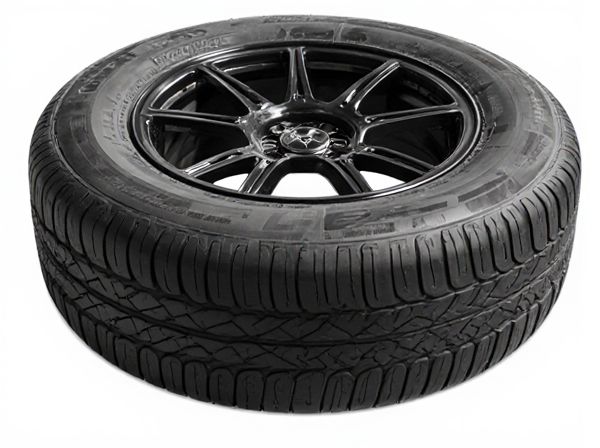
Photo illustration: Retreaded Tire vs New Tire
Retreaded tires provide a cost-effective and environmentally friendly alternative to new tires by recycling the tire casing and applying new tread. You can expect retreaded tires to offer comparable performance and durability for everyday driving, though new tires typically deliver better traction and longevity, especially in extreme conditions. Choosing between the two depends on your budget, driving needs, and willingness to prioritize sustainability.
Table of Comparison
| Feature | Retreaded Tire | New Tire |
|---|---|---|
| Cost | 30-50% less expensive | Higher initial cost |
| Durability | 70-80% lifespan of new tire | Full lifespan (100%) |
| Performance | Comparable for regular driving | Optimal handling and safety |
| Environmental Impact | Reduces waste, eco-friendly | Higher resource consumption |
| Warranty | Limited warranty periods | Comprehensive manufacturer warranty |
| Safety | Safe when properly retreaded | Maximum safety standards |
Introduction to Retreaded and New Tires
Retreaded tires undergo a process where worn tread is replaced on the original tire casing, offering a cost-effective and eco-friendly alternative to new tires. New tires are manufactured from raw materials, featuring advanced tread designs and compounds that provide optimal performance, safety, and durability. Both options serve distinct applications, with retreaded tires commonly used in commercial trucking and new tires preferred for passenger vehicles demanding peak efficiency and traction.
What Are Retreaded Tires?
Retreaded tires are used tires that have had their worn tread replaced with new rubber, extending the tire's lifespan while maintaining safe performance standards. These tires are carefully inspected and processed to ensure durability and reliability, providing a cost-effective and environmentally friendly alternative to new tires. Fleet operators and commercial vehicles commonly use retreaded tires due to their balance of safety, quality, and reduced environmental impact.
Benefits of Retreaded Tires
Retreaded tires offer significant cost savings, often priced at 30-50% less than new tires, making them an economical choice for fleet operators and individual drivers. They promote environmental sustainability by reducing tire waste and conserving raw materials such as rubber and oil, contributing to lower carbon emissions during production. Additionally, retreaded tires maintain performance standards comparable to new tires when properly manufactured and inspected, providing reliable durability and safety on the road.
What Are New Tires?
New tires are manufactured from fresh rubber compounds and designed with advanced tread patterns to provide optimal grip, durability, and safety on the road. They undergo rigorous quality control and testing to meet industry standards, ensuring maximum performance and longevity. Unlike retreaded tires, new tires offer the latest technology in tread design and materials, enhancing fuel efficiency and driving comfort.
Advantages of New Tires
New tires provide enhanced safety due to their superior tread depth and consistent rubber quality, resulting in improved traction and handling on various road surfaces. They offer longer tread life and better resistance to road hazards like punctures or blowouts compared to retreaded tires. New tires also maintain vehicle warranty compliance and manufacturer specifications, ensuring optimal performance and reliability.
Cost Comparison: Retreaded Tire vs New Tire
Retreaded tires cost significantly less than new tires, often priced at 30-50% lower, making them a budget-friendly option for fleet operators and individual drivers. The savings come from reusing the tire casing and replacing only the worn tread, reducing manufacturing materials and labor expenses. While new tires offer longer lifespan and better performance, retreaded tires provide substantial upfront cost benefits without compromising safety when properly inspected and maintained.
Performance Differences: Traction, Safety, and Durability
Retreaded tires generally offer comparable traction to new tires but may exhibit slightly reduced grip in wet or icy conditions due to variations in tread depth and rubber compound. Safety performance can differ, as retreaded tires rely heavily on the quality of the retreading process, with well-maintained retreads meeting industry standards but potentially increasing the risk of blowouts if damaged or poorly retreaded. Durability tends to be lower in retreaded tires, as their lifespan is dependent on both the tire casing's integrity and the quality of the new tread application, often resulting in shorter service life compared to factory-new tires.
Environmental Impact: Retreaded vs New Tires
Retreaded tires significantly reduce environmental impact by conserving raw materials, lowering energy consumption, and minimizing landfill waste compared to new tires. Manufacturing new tires requires extensive natural resources, including rubber, oil, and chemicals, resulting in higher carbon emissions and ecological footprint. Choosing retreaded tires supports sustainable practices by extending tire life and reducing the demand for resource-intensive production processes.
Common Myths and Misconceptions
Retreaded tires often face misconceptions regarding safety and durability, yet modern retreading processes use rigorous quality controls that make performance comparable to new tires. Common myths suggest retreaded tires wear out faster or are prone to blowouts, but studies show they can offer reliability and cost-efficiency when properly maintained. Consumer education on the retreading process, including inspection and tread application, helps dispel fears and promotes environmentally sustainable tire use.
Choosing the Right Tire for Your Vehicle
Choosing the right tire for your vehicle depends on factors such as budget, driving conditions, and lifespan expectations. Retreaded tires offer cost-effective performance with similar tread patterns to new tires but may have a shorter lifespan and reduced safety margins for high-speed or heavy-load driving. New tires provide optimal traction, updated technology, and longer durability, making them ideal for ensuring maximum safety and fuel efficiency on varied road surfaces.
 caratoz.com
caratoz.com